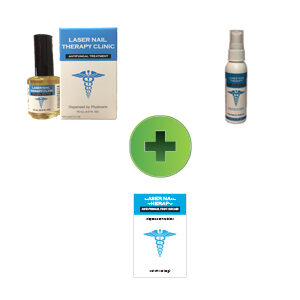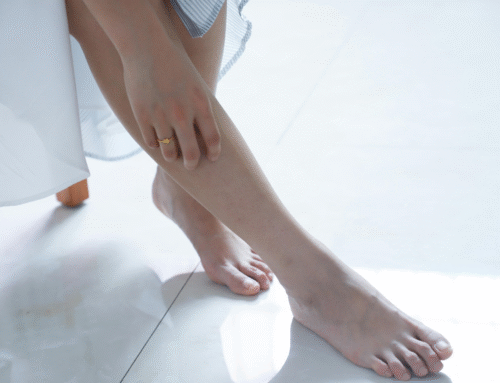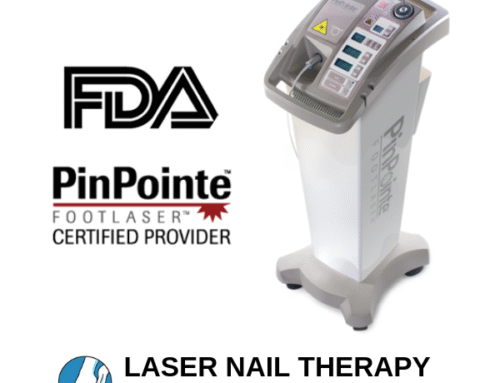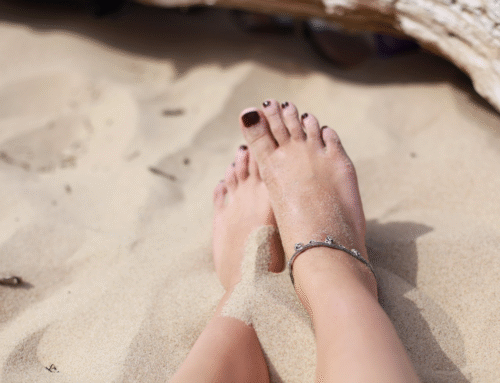Laser toenail fungus treatment in San Diego can vary. Our nail doctors are specialists in toenail fungus. They will consult you first. Our nail doctors will determine if what you have is a toenail fungus. Afterward, they will explain their recommended treatment option.
Treatment Options for you
The most common treatment option is topical solutions. Here are a few reasons why topical solutions are not the best treatment option for toenail fungus
- They have a cure rate of about five to ten percent
- Over-the-counter medication
- This means that it is most likely not strong enough to kill all the fungus
- The topical solution typically only stays on your nail
- As a result, it does not penetrate through the nail bed
Another common treatment option is an oral medication. Here are a few reasons why our nail specialists do not recommend this treatment for toenail fungus.
- This can lead to liver toxicity
- It can cause other health problems in people who have underlying health issues

Toenail Fungus
Toenail fungal infection is hard to treat and is likely to return if not treated effectively. Laser therapy is non-invasive, safe, effective, and painless. Patients often report the sensation of warmth in the treatment area.
Through the FDA’s clinical study, their results found the PinPointe Foot Laser ™ effectively cleared the appearance of the nail 6-12 months post-treatment. There are other brands of lasers available, but when looking at the PinPointe Foot Laser, researchers found improvements in the appearance of the nail in as few as 90 days.
Commonly Asked Questions About Toenail Fungus
What are the most common misconceptions about toenail fungus treatments?
-
- One prevalent misconception is that toenail fungus is a cosmetic issue rather than a medical one. Many people believe that over-the-counter creams or home remedies can effectively treat it. However, toenail fungus is a persistent infection that requires targeted medical intervention. Another misconception is that the condition will resolve on its own without treatment. In reality, untreated toenail fungus can lead to more severe complications and the spread of the infection.
Are over-the-counter treatments effective in addressing toenail fungus?
-
- Over-the-counter treatments may provide temporary relief for mild cases, but they often lack the potency needed to eradicate the infection completely. Additionally, self-diagnosing and treating without professional guidance can lead to delays in receiving proper care. Consultation with a qualified podiatrist is crucial for accurate diagnosis and a tailored treatment plan, which may include prescription medications, topical treatments, or, in some cases, laser therapy.
Can toenail fungus be treated with home remedies?
-
- While home remedies like tea tree oil or vinegar soaks are popular, their efficacy in treating toenail fungus is limited. Mild cases might see some improvement, but severe infections require medical intervention. It’s essential to consult a podiatrist for an accurate diagnosis and appropriate treatment, as relying solely on home remedies can result in the progression of the infection.
What role does podiatry play in toenail fungus treatment in San Diego?
-
- Warm and humid conditions can contribute to toenail fungus growth in cities like San Diego, and podiatrists play a crucial role in diagnosis and treatment. Podiatrists are trained to identify the specific type of fungus causing the infection and prescribe targeted medications. They can also provide valuable guidance on preventive measures to minimize the risk of recurrence.
Are prescription medications the most effective treatment for toenail fungus?
-
- Prescription medications, such as oral antifungal drugs, are often more potent than over-the-counter options. However, their effectiveness varies from person to person, and they may have side effects. Laser therapy is another option gaining popularity for its ability to target the fungus directly. The choice of treatment depends on the severity of the infection, the patient’s health, and their preferences.
How long does toenail fungus treatment take?
-
- The duration of toenail fungus treatment varies depending on the severity of the infection and the chosen treatment method. Some treatments may take several months to yield results. Consistency in following the prescribed treatment plan, good foot hygiene, and preventive measures are essential for successful outcomes.
What causes a toenail fungus infection?
-
- The fungus can live in the layer of dead skin around your nails, in the space under your nail, and in the nails themselves. Fungal nail infections often result from damage to the nail plate or the surrounding area. Skin infections or athlete’s foot invade the nail, causing the infection. Up to 30 percent of patients with fungal nail infections also have fungal skin infections. Hot, sweaty feet in fully enclosed shoes provide the ideal warm, damp environment for fungus to grow and multiply. Factors that increase the risk of nail infections are:
- nail damage (e.g., activities that cause trauma to the nail)
- medications that weaken the immune system
- smoking
- general poor health
- walking barefoot in public areas
Medical conditions like diabetes and poor circulation can create the potential for worsening conditions such as secondary bacterial infections. The fungus can thrive when the foot is contained in warm, damp shoes for a long time. Poor foot hygiene, walking on contaminated floors, and the use of badly sterilized nail cutting and filing equipment are other ways the feet can be exposed to the fungus.
Athletes wear closed-toed shoes for many hours in the day, due to practice or when they have a competition. Since they have shoes for long periods of time, it creates moisture, which allows the fungus to develop in athletes. Swimmers are more at risk for toenail fungus because they tend to shower in public places, which can be an issue for toenail fungus. When taking a shower in public areas, it is important to wear shower sandals because a lot of people shower in these public places. As well, they are more at risk of developing athlete’s feet, which affects the skin of the feet, and itching occurs.
- The fungus can live in the layer of dead skin around your nails, in the space under your nail, and in the nails themselves. Fungal nail infections often result from damage to the nail plate or the surrounding area. Skin infections or athlete’s foot invade the nail, causing the infection. Up to 30 percent of patients with fungal nail infections also have fungal skin infections. Hot, sweaty feet in fully enclosed shoes provide the ideal warm, damp environment for fungus to grow and multiply. Factors that increase the risk of nail infections are:
Toenail Fungus Prevention
Prevention of nail fungus is important. One way of getting a nail fungus is skin-to-skin contact with people who already have it or other fungal infections on their skin, such as Athlete’s foot. Another way of getting fungi in your nails is through objects. You can get nail fungus by walking barefoot in a warm and moist area, such as a public pool, or by sharing an infected nail clipper or shoes.
In addition to those conditions above, simply age can be a factor too – older adults are more prone to getting fungal nail infections. If you have these conditions above, be extra careful with the fungal nail infection. If you notice any changes in your nails, ask your doctor immediately.

If you’re looking to avoid getting toenail fungus, follow the following steps:
- Wash your feet daily with soap and water.
- After washing your feet, make sure to dry them thoroughly.
- Cut your toenails straight across with clean nail clippers.
- Wear shoes in areas where fungus can grow. (For example, swimming pools, spas, or locker rooms.)
Impact of Toenail Fungus: From Discomfort to Secondary Infection Risk
The impact of toenail fungus on your feet and overall health is more significant than you might think. From physical discomfort to emotional distress, this common condition can take a toll on your well-being. Here’s how it may affect your health:
Physical Discomfort and Pain
A yellow or white dot starts under the nail, leading to toenail fungus. An untreated infection can cause thickened, brittle, and discolored nails. As the infection progresses, your nails can become painful, making walking and wearing shoes uncomfortable.
Increased Risk of Secondary Infections
Fungal infections can weaken your nails’ natural defenses, making them susceptible to bacterial infections. When your toenails are infected, the risk of developing bacterial infections like cellulitis increases. These infections can spread beyond your feet, affecting your overall health.
Impact on Mobility and Daily Life
The physical discomfort and pain associated with toenail fungus can limit your mobility and interfere with daily activities. If walking becomes painful, it may lead to a sedentary lifestyle, which can have adverse effects on your overall health.
Emotional and Psychological Impact
The appearance of infected toenails can be embarrassing and lead to low self-esteem and self-confidence issues. The social stigma associated with toenail fungus can affect your mental health and overall well-being.
Laser Treatment for a Toenail Fungus in San Diego
Toenail fungus can be a persistent and bothersome condition. Additionally, its treatments in San Diego may also vary. If you have caught nail fungus, luckily, residents of San Diego can access a convenient and effective option that typically only takes one sitting. The FDA-approved PinPointe Laser is the most reliable alternative to toenail fungus treatment. When it comes to tackling toenail fungus, not all treatments are created equal. Other toenail fungus treatments, like topical solutions and oral medication, are not as effective.
Topical solutions have a relatively low cure rate because they struggle to penetrate all the way through the nail bed to eradicate the fungus. On the other hand, oral medications can be potent, but they can lead to liver toxicity. Patients taking these medications for toenail fungus must undergo consistent blood tests throughout the treatment course to monitor potential side effects.
Is it Effective?
Another study found that patients experienced approximately 80% improvement in all nails treated 6 months post-treatment. Clinical trials with Laser therapy continue to improve the quality and effectiveness of the treatment. For now, Laser therapy for onychomycosis appears to be a strong competitor with oral and topical drug treatment options.
Laser Nail Therapy Experience
Our experienced nail doctor in San Diego, CA, highly recommends PinPointe Laser treatment for toenail fungus. The PinPointe Laser treatment has the highest cure rate in the market and is favored for its convenience and safety. Unlike other treatment options, there are no known side effects associated with the PinPointe Laser, and there’s no need for a lengthy recovery period. As a result, you can go about your daily activities right after a single treatment session without any discomfort or pain.
If you suspect you may have toenail fungus or have noticed any signs of this condition, we encourage you to take action promptly. Reach out to us at 800-672-0625 at our San Diego, CA, location to schedule an appointment with our podiatrist. You can also visit our website for more information on our expert podiatrists at one of our over 150 locations nationwide.
Don’t let toenail fungus disrupt your life any longer. With the PinPointe Laser treatment, you can take a significant step towards clear and healthy toenails, all while enjoying the beauty and vibrant lifestyle that San Diego has to offer.
Fun things to do in San Diego, CA
San Diego, California, is a sun-soaked destination known for its stunning beaches, rich history, and vibrant culture. From the artistic beauty of Balboa Park to the coastal charm of La Jolla Cove and the lively boardwalks of Mission Beach, the city offers a perfect mix of relaxation and adventure.
Family-fun activities
San Diego is a coastal paradise that perfectly blends outdoor adventure, cultural landmarks, and seaside relaxation. One of the city’s crown jewels is Balboa Park, a 1,200-acre urban oasis filled with gardens, museums, theaters, and architectural beauty. This park is not only home to the world-renowned San Diego Zoo but also houses over a dozen museums, including the Museum of Art and the Air and Space Museum. Visitors can wander through its Spanish-Moorish buildings, enjoy vibrant gardens, and relax under palm trees while taking in the artistic and historical atmosphere. Balboa Park captures the city’s creative spirit and is a must-see for anyone looking to experience San Diego’s cultural side in one picturesque setting.
Iconic spots
Another highlight of San Diego is La Jolla Cove, a stunning coastal spot famous for its dramatic cliffs, turquoise waters, and playful sea lions lounging along the shore. The cove is ideal for snorkeling, kayaking, or simply enjoying a walk along the bluffs that overlook the Pacific Ocean. Nature lovers will appreciate the opportunity to spot marine life up close, while photographers will be captivated by the breathtaking ocean views and sunsets. For those who prefer a laid-back visit, nearby shops and restaurants offer plenty of options to dine with a seaside view. La Jolla Cove embodies the quintessential Southern California charm, where nature’s beauty meets a relaxed coastal lifestyle.
Fun by the beach
For visitors craving the classic beach experience, Mission Beach delivers with its energetic boardwalk and lively atmosphere. Stretching for miles, the beach is perfect for swimming, surfing, or biking along the oceanfront path. A major attraction here is Belmont Park, a vintage-style amusement park complete with a wooden roller coaster, arcade games, and ocean-view dining. Whether you’re enjoying the thrill of the rides or soaking up the sun on the sand, Mission Beach offers fun for all ages. As the day winds down, the area transforms into a perfect spot to catch the sunset over the Pacific, creating an unforgettable Southern California experience filled with sun, surf, and nostalgia.
A walk through history
Rounding out the San Diego experience are its rich historical and natural landmarks. The USS Midway Museum, located along the downtown waterfront, offers visitors a chance to explore a historic aircraft carrier turned museum, providing fascinating insight into naval aviation history. Nearby, Seaport Village features boutique shops, waterfront dining, and charming walkways that make for a relaxing afternoon by the bay. For those seeking outdoor serenity, Torrey Pines State Natural Reserve offers scenic hiking trails with panoramic ocean views and rare pine forests found only in this region. This breathtaking reserve allows visitors to connect with nature while taking in the rugged coastline that defines San Diego’s landscape. From urban exploration to coastal beauty, San Diego offers an endless array of experiences that capture the heart of California’s golden coast.
Schedule a Consultation
If you have any signs of toenail fungus, don’t wait. Our San Diego, CA nail doctors offer the PinPointe laser treatment, the most effective and safe method for curing toenail fungus. Call us today at (800) 672-0625 or visit our website to schedule a free consultation at a location near you.




